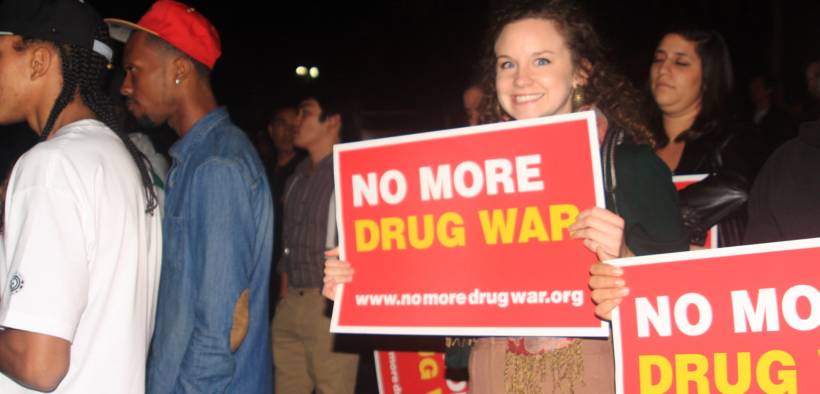2019 Was a Banner Year for Drug Reform

Drug reform achieved some major milestones in 2020 including reining in civil asset forfeiture and freeing thousands of inmates under the First Step Act.
As the clock ticks down toward 2020, it’s worth taking a moment to look back and reflect on what has gone on in the world of drug policy this year. From marijuana to psychedelics to the lingering overdose crisis to the emergence of a new vaping-related illness, a lot happened. Here are some of the highlights.
For the First Time, Marijuana Legalization Wins a Congressional Vote
In November, the House Judiciary Committee made history when it approved the Marijuana Opportunity Reinvestment and Expungement (MORE) Act (H.R. 3884). The bill would effectively legalize marijuana at the federal level by removing it from the Controlled Substance Act’s drug schedules. It would also require federal courts to expunge prior convictions and conduct re-sentencing hearings for those still doing federal marijuana time. And it would assess a 5 percent tax on marijuana sales to create a fund to aid the people and communities most impacted by pot prohibition.
There’s a good chance the MORE Act will get a House floor vote before the end of this Congress, but even if it does, its prospects in Sen. Mitch McConnell’s Senate are dim at best. Still, step by step, Congress by Congress, the end of federal pot prohibition is drawing nearer.
Marijuana Legalization in the States Didn’t Have a Great Year
At the beginning of 2019, prospects looked good for as many as a half-dozen states to get legalization bills passed, but the year turned out to largely be a dud. Hopes were especially high in New Jersey and New York, where Democratic governors supported legalization, but it didn’t come to pass this year in either state. In Albany, they’ll be back at it next year, but in Trenton, it looks like the legislature is going to punt, opting instead to put the issue directly to the voters next year in a legislative referendum.
One state did make it all the way to the finish line: Illinois. After a legalization bill sailed through the legislature in the spring, Democratic Gov. J.B. Pritzker signed it into law in late June. With that signature, Illinois became the first state to create a system of taxed and regulated marijuana commerce through the legislative process rather than through a voter initiative (Vermont’s legislature legalized pot possession and cultivation but not sales in early 2018).
Getting bills through a state legislative is hard work, and it sometimes takes years. Still, that hard work that didn’t quite make it over the top this year is laying the groundwork for legalization in places like New Jersey and New York—and maybe more—next year. And next year is an election year, which means initiative campaigns that can bypass legislative logjams will be in play. There are already active campaigns in Arkansas, Florida, North Dakota, and South Dakota, although none of them has yet qualified for the ballot. Look for 2020 to be a better year when it comes to freeing the weed.
Pot Prohibition Isn’t Dead Yet: Despite Legalization, Marijuana Arrests Are Up in Latest FBI Crime Report
In late September, the FBI released its annual Uniform Crime Report for 2018, and once again, marijuana arrests were on the rise—despite legalization in 11 states and D.C. and decriminalization in 15 more states. There were some 663,367 marijuana arrests in 2018, up from 659,700 in 2017 and 653,249 in 2016. In all three years, simple possession cases accounted for about nine out of 10 pot busts. Before 2016, pot arrests had been going down for more than a decade. Clearly, there is still work to do here.
U.S. Supreme Court Unanimously Reins in Asset Forfeiture
In a February victory for proponents of civil asset forfeiture reform, the U.S. Supreme Court ruled in Timbs v. Indiana that the Eighth Amendment’s Excessive Fines Clause applies to states, thereby prohibiting state and local governments from collecting excessive fines, fees and forfeitures. Justice Ruth Bader Ginsburg wrote the majority opinion. “[T]he protection against excessive fines guards against abuses of government’s punitive or criminal-law-enforcement authority,” Ginsburg wrote. The case involved the seizure of a $42,000 Land Rover over a drug sale of $225.
There was more progress on the asset forfeiture front on the state level, too: Bills to either end civil asset forfeiture entirely or to restrict it passed this year in Alabama, Arkansas, Michigan, and North Dakota, and a South Carolina circuit court judge ruled civil asset forfeiture unconstitutional, setting up a fight in state appeals courts there.
Thousands of Federal Drug Prisoners Go Free Under First Step Act
President Trump signed the First Step Act into law at the end of 2018, but the sentencing reform measure’s true impact was felt in July when the Bureau of Prisons released more than 3,000 prisoners and reduced the sentences of nearly 1,700 more. Almost all of those released were drug offenders. The First Step Act was aimed at redressing harsh sentences for federal prisoners excluded from the 2010 Fair Sentencing Act, which reduced—but did not eliminate—the infamous crack/powder cocaine sentencing disparity, but which did not include prisoners sentenced before its passage. Three states—Florida, South Carolina, and Virginia—accounted for a whopping 25 percent of sentence reductions, and more than 90 percent went to African American men.
Psychedelic Decriminalization Becomes a Movement
After emerging in 2018, the movement to decriminalize natural psychedelics mushroomed this year. In May, voters in Denver narrowly approved the Denver Psilocybin Mushroom Decriminalization Initiative, making clear that they wanted to “deprioritize, to the greatest extent possible, imposition of criminal penalties on persons 21 years of age and older for the personal use and personal possession of psilocybin mushrooms.” The measure also “prohibit[s] the City and County of Denver from spending resources on imposing criminal penalties on persons 21 years of age and older for the personal use and personal possession of psilocybin mushrooms.”
That surprising victory sparked interest across the country, and the following month Oakland followed suit, only this time it was the city council—not the voters—who approved the decriminalization of magic mushrooms and other natural psychedelics. In October, Chicago became the next city to get on board, with the city council passing an advisory resolution expressing support for research on the potential use of psychoactive plants and pledging support for adult use of the substances. Meanwhile, activists in three more major cities—Berkeley, Dallas, and Portland—were pushing psychedelic decriminalization measures, either through ballot initiatives or city council actions. By December, Decriminalize Nature, the group behind the movement, reported that nearly 100 cities across the country are now seeing efforts to open up to psychedelics.
And it’s not just cities. In two states, psychedelic reformers have filed initiatives aimed at the November 2020 ballot. In the Golden State, the California Psilocybin Mushroom Decriminalization Initiative, which would decriminalize the possession, use, and gifting of magic mushrooms and the chemical compounds—psilocybin and psilocin—has been cleared for signature gathering. It has until April 21 to come up with 623,212 valid voter signatures to qualify for the November 2020 ballot. Just across the border to the north, the Oregon Psilocybin Service Initiative, which would allow magic mushrooms to be grown with a license, and would allow for the therapeutic use of psilocybin, is in the midst of signature gathering. It needs 112,020 valid voter signatures by July 2 to make the ballot. The Oregon measure in September got a nice $150,000 donation from Dr. Bronner’s Magic Soaps.
Overdose Deaths Decline Slightly But Are Still Way Too High
In July, the CDC reported 2018 drug overdose death numbers and found that they had declined from 2017’s record high of more than 70,000 to just under 68,000. The latest data from CDC, which measured drug deaths in the 12-month period ending in May 2019 showed deaths at 67,000, suggesting that the decline continues, but at a glacial pace. Still, the number of overdose deaths is about seven times higher than it was in 1995, at the start of the prescription opioid epidemic.
The recent decline has been driven by a decrease in heroin and prescription opioid overdoses, although overdoses involving the synthetic opioid fentanyl increased, as did those involving the stimulant drugs cocaine and methamphetamine. Many overdoses involved more than one drug, with benzodiazepines often implicated.
Vaping-Linked Illness Emerges, Sparking Broad Anti-Vaping Backlash
In the summer, reports of vaping or e-cig users being struck down by a mysterious, lung-damaging condition began to emerge. By the end of October, the Centers for Disease Control and Prevention (CDC) reported more than 1,600 cases of lung-damaged vapors, with the death toll rising to 34. (That number has since risen to 54.) The CDC also gave the condition a name: e-cigarette or vaping product use associated lung injury (EVALI).
A likely culprit soon emerged: black market THC vaping cartridges contaminated with new additives, particularly thinners including propylene glycol (PG) and polyethylene glycol (PEG), vitamin E acetate, and medium-chain triglycerides (MCT oil). The FDA has begun investigating vitamin E acetate, while public health officials in New York have found the substance in a majority of seized vape cartridges there. The FDA also announced in August that it is proposing adding propylene glycol as a “respiratory toxicant” in its list of harmful tobacco product ingredients.
While the CDC and the FDA responded to the outbreak with recommendations targeting the suspect products, elected and public health officials in a number of states responded by going after not black-market marijuana vaping cartridges but legal flavored tobacco vaping products.
Massachusetts banned all vaping products, Michigan banned flavored nicotine products, New York banned flavored e-cigarettes, and Oregon banned all flavored vaping products for six months, as did Rhode Island, while Washington issued a four-month ban on flavored vaping products. President Trump threatened to move toward a national ban on flavored vaping products but has since changed course, even making an anti-prohibitionist argument to do so.
In its latest update, the CDC reports the number of EVALI cases has risen to nearly 2,500 and the death toll has climbed to 54. But unlike those state governments that reacted with flavored vaping bans, the CDC takes a different approach: It points the finger strongly at vitamin E acetate, recommends that people not use THC vaping products at this point—especially if obtained informally or in the black market—and also warns people not to add any products to vaping cartridges that are not intended by the manufacturer.
This article was produced by Drug Reporter, a project of the Independent Media Institute.









